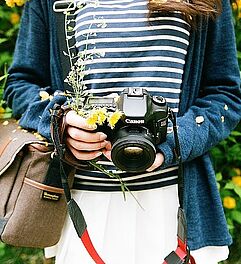10 großartige Foto-Tipps im Frühling
Was nicht jeder weiß: Neben artistravel.eu erreicht man unter www.artistravel.eu/en auch unsere englischsprachige Webseite, auf der wir auch internationale, englischsprachige Kurse vermitteln. Außerdem hat unsere kleine artistravel-Schwester ebenfalls einen eigenen Blog. Die Beiträge sind dort zwar natürlich auch auf englisch, trotzdem möchte ich Ihnen diesen Beitrag aus dem Februar nicht vorenthalten. Denn Fotografieren funktioniert in jeder Sprache gleich und die ersten Frühlings-Sonnentage haben sich ja bereits angekündigt!
Repost:
10 Great Tips for Photography in Spring
Yes, it is finally coming again: the warm and beautiful time of spring. For photographers, this means to dust off their cameras, reach for their lenses and head out for the first colourful and sunshiny shots in this most beautiful season of the year. To help you improving your sunshiny photographs, we collected 10 great tips for successful phototours in the springtime.
1. Taking pictures in the bright sunshine
The best way to catch the brightest sunshine in your spring photos is pretty simple: be in the sunniest place! If you don’t have the chance to go on a walk across the beach, just pay attention to your current environment outside: which place is mostly hit by sunbeams? If you take a sunny portrait picture of a person outside, remember to use fill flash. Due to the harsh shadows which the sun creates, somebody who is wearing sunglasses or a hat might have large shadowy areas in the face when portrayed by a photographer. Letting your flash go off - even though the sun is shining brightly - will illuminate these dark and shadowy areas from anybody’s face.
2. Experiment with bulb exposure
You can give your outdoor photos in spring a new touch by adding some experimental methods to your usual procedures. For example, you can experiment with bulb exposure: Look for a beautiful landscape and then try to pan your camera upwards during the bulb exposure. These methodical experiments will result into whole new and exciting effects!
3. Attention: White Balance!
Adjusting the white balance is very important for capturing the greatest luminous colours in your images. What you can see with your eyes should exactly match what you see on your screen. You can gauge the accuracy of the adjustments by matching a lighter color closely.
4. Get inspired by your surroundings!
Many photographers tend to only focus on new flowers coming out for their first springtime photos. But instead of following this typical stereotype, you should open your eyes for all of the beautiful surroundings you can encounter during the beginning of spring: trees starting to bud, people enjoying the first warm sunbeams or dogs playing in the parks of your city. Be creative and open up for new inspirations!
5. Landscape photos are great with rain!
If you never leave the house with your camera on rainy days, then one thing is for sure: There are great opportunities for landscape photography which you will definitely miss out! Clear showers of rain can give you dramatic lighting: there is spotlight on the landscape below the dark clouds of a rain shower or a thunderstorm. After the rain washed all the particles out of the air and atmosphere, you can experience an immense clarity which makes for perfectly clear shots. When the sun shines through the clouds and a rainbow appears, you can enhance its colours by using a polariser.
6. Adjust your outdoor settings!
Throughout the winter, you and your camera have spent a lot of time inside your cozy home, but now it is time to go outside again for the first spring shots. Make sure that your camera settings are ready for the first days of spring. Take some time to adjust these settings before you head out for the first sunshiny photo adventure of the year!
7. Mystical misty mornings
Check the weather forecast so you know when it is going to be misty in the morning. Spring is the perfect season for finding misty conditions outside after a clear night during which the temperature went down a little. The best condition for the development of mist is a gentle breeze from the South West. The scene of a misty landscape has a certain romantic atmosphere which is being simplified by the mist. Radiation fog lies on the ground and is known as the most photogenic mist type. It is often found in valleys and looks amazing when being shot with hill tops and trees above it.
8. Using a polariser is worth it!
The springtime is full of colours: yellow fields, green leaves, bright and colourful wildflowers. In some photos, these bright shining colours might look a bit washed out. This is caused by glare on the surfaces of flowers or a haze in the air which dulls the colours. The solution: a polarising filter that cuts out polarised light. It reduces the glare and surface reflections. Don’t hesitate to use the polariser, it is very easy to operate! While looking through the viewfinder, you just need to rotate the filter until the wanted effect appears.
9. Capturing flower carpets
Most photographers usually get in close with their wide-angle lenses when they see a large and colourful flower carpet in spring. Unfortunately, this procedure sometimes tends to exaggerate the gaps between the individual flowers. To avoid this unwanted effect, you can try to shoot the flowers from a wider distance with a longer lens. The gaps will be compressed so that the flowers look as densely bundled as they appear in reality.
10. Last but not least: Flare!
Usually, photographers don’t want any flare in their images, but the sunshiny season of spring is a nice exception (or excuse) to literally and intentionally add some sun flare to your pictures. It will give them a nice mood which makes for an airy, light and bright feeling, just like spring itself.
In diesem Sinne: Have a wonderful weekend!
Jana


